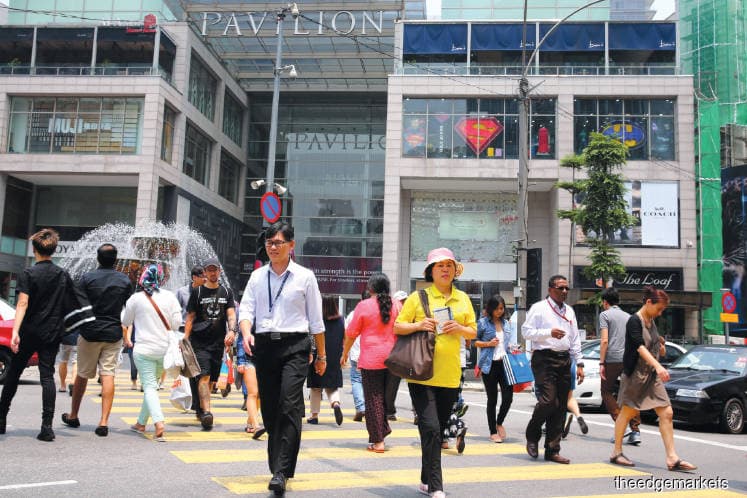
This article first appeared in The Edge Malaysia Weekly on March 19, 2018 - March 25, 2018
WHEN the Consumer Price Index (CPI) for January was released at end-February, the figure came as a surprise to some as inflation slowed to 2.7% — the slowest pace since December 2016.
Some economists believe an update in January to the CPI basket of goods and services resulted in a slightly lower rate of inflation compared to the projected 2.8%. (Economists had expected a moderation in the inflation rate because of the high-base effect of the first six months of 2017.)
The Department of Statistics Malaysia had updated the basket to reflect the latest findings in the Household Expenditure Survey 2016. The move, the department says, ensures that statistics reflect the current patterns in consumer expenditure. Before that, the basket was based on a 2014 survey.
According to some economists, that resulted in a slight change in weightage of the CPI’s 12 sub-groups.
“Overall, it points to households now spending more of their income on transport, household items and services, education and health amid lower shares of income being spent on food and beverages, tobacco and communications as well as recreational services and culture,” says Maybank Investment Bank in a report.
Julia Goh, senior vice-president of global economics and market research at UOB Malaysia, remarks, “I think it’s partly due to lower weights for the large items such as food and non-alcoholic beverage while upward revisions were made to the smaller components.”
Socio-economic Research Centre executive director Lee Heng Guie points out that revisions were made to the transport component, which rose 0.9% owing to higher weights for fuel and lubricants as well as repair and maintenance, while there was a 0.7% reduction in weight for food and non-alcoholic beverage.
For January, the lower inflation of 2.7% year on year was mostly due to the slower rise in food and beverage costs as well as retail pump prices. The price of RON95 petrol increased by 20 sen between December 2016 and January 2017, compared to a one sen rise between December 2017 and January 2018.
As for food and non-alcoholic beverages, the CPI showed that it had moderated to 3.8% y-o-y in January compared with 4.1% last December. Maybank IB Research opines that food price inflation may be contained going forward given the decline in the UN’s Food and Agriculture Organisation’s global food price index.
CPI and cost of living disconnect
While the CPI is showing significant moderation, consumers do not feel it is reflective of the increase in general price levels they are faced with. There is often scepticism about inflation numbers because of the disconnect consumers feel on what the average household pays for the consumption of goods and services and reported changes of general price levels in major components of the CPI basket.
That said, it is worth noting that the CPI does not reflect a particular consumer’s expenditure, but only the average spend.
Perhaps the larger question is whether wages are keeping up with the increase in the prices of goods.
“It is reckoned that overall inflation would not reflect the individual cost of living, but price increases exceeding the rise in wages and gross income erodes the purchasing power and hence, equates to less disposable income. Households have to fork out more money to consume the same basket of goods and services or even cut down on other expenses given the tighter budget because of rising living costs,” Lee points out.
An observer highlights that prices have gained significantly since the implementation of the Goods and Services Tax in 2015 while the poor economic climate in 2015 and 2016 — with a weak ringgit and depressed crude oil prices — did not help.
The normalisation of inflation, he says, just means that prices are increasing at a slower pace but those who have been affected by the economic situation have yet to see their consumption spending return to the pre-GST period.
Between 2015 and 2017, the overall CPI increased by 5.3%, with higher price hikes seen in food and non-alcoholic beverages (7.6%), housing and utilities (4.3%), transport 10.8%), health services (4.7%), restaurants and hotels (4.5%).
Lee adds that the rising cost of living has taken a heavy toll on low and middle-income households, although the yearly cash handouts do provide some relief.
“Many households and consumers remain severely cash constrained and highly leveraged. The household debt to gross domestic product (GDP) ratio remains high at 84.6% at end-September 2017, though it has eased from 89.1% of GDP at end-2015.
Stretched net savings — the difference between mean income and expenditure — of the B40 and M40 households of RM54 per month and RM365 per month respectively in 2014, means any unwarranted shocks to employment and income, expenditure shocks or higher prices could dampen their balance sheets and temper spending and consumption, he explains.
With inflation moderating, many economists do not anticipate another interest rate hike by the central bank this year. The latest adjustment to the overnight policy rate was in January when it was raised by 25 basis points to 3.25%.
Based on Bloomberg data, the average inflation forecast for 2018 is 2.9% compared to last year’s 3.7%.
The Statistics Department will be releasing the February CPI numbers on Wednesday.
Save by subscribing to us for your print and/or digital copy.
P/S: The Edge is also available on Apple's AppStore and Androids' Google Play.